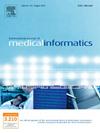个性化员工健康检查的数据驱动评分框架:整合历史实验室趋势和基于证据的流行率
IF 4.1
2区 医学
Q2 COMPUTER SCIENCE, INFORMATION SYSTEMS
International Journal of Medical Informatics
Pub Date : 2025-05-18
DOI:10.1016/j.ijmedinf.2025.105974
引用次数: 0
摘要
不断上升的医疗成本和对个性化预防保健的需求日益增长,突出了对数据驱动方法的需求,以优化健康检查,特别是在企业环境中。本研究提出了一个基于评分的平台,旨在通过整合历史健康数据和疾病患病率,对员工个体进行实验室测试,以提高常规健康评估的准确性和效率。方法该平台主要由两个部分组成。首先,通过对266项研究(从最初的28,558项研究)进行系统回顾和荟萃分析,建立了一个患病率模型,提供了通过实验室检测可检测到的各种疾病的患病率估计。其次,利用员工健康记录建立个人历史实验室评分(IHLS)模型。IHLS结合了三个指标:(1)每个测试的流行分数,(2)基于相对于参考范围的当前实验室值的异常分数,以及(3)使用最小二乘误差的线性趋势估计得出的趋势分数。这些组件被启发式地组合起来,对每个人的检查项目进行排名。该模型使用了6年(2016-2022年)的纵向健康检查数据,这些数据来自7个商业实体的3198名员工(总计7518份记录;平均随访时间:3.4年;平均年龄:39.3±9.6岁;29.3%男性)。采用受试者工作特征(ROC)曲线分析评估模型的性能。IHLS的曲线下面积(AUC)为0.82,优于仅患病率模型(AUC = 0.77)和随机基线(AUC = 0.50)。结论该原型平台展示了信息学驱动的评分系统在增强个性化健康检查建议方面的潜力。通过将个人实验室病史与基于人群的患病率数据相结合,该模型支持早期风险识别和具有成本效益的筛查策略,为工作场所健康计划提供实际应用,并可扩展到更广泛的卫生系统中。本文章由计算机程序翻译,如有差异,请以英文原文为准。
A data-driven scoring framework for personalized employee health check-ups: Integrating historical laboratory trends and evidence-based prevalence
Introduction
Rising healthcare costs and growing demand for personalized preventive care have highlighted the need for data-driven approaches to optimize health check-ups, particularly in corporate settings. This study presents a scoring-based platform designed to prioritize laboratory tests for individual employees by integrating historical health data with condition prevalence, aiming to improve the precision and efficiency of routine health assessments.
Methods
The platform integrates two main components. First, a prevalence model was developed through a systematic review and meta-analysis of 266 studies (from an initial 28,558), providing prevalence estimates for various conditions detectable through laboratory testing. Second, the Individual Historical Lab Score (IHLS) model was built using employee health records. IHLS combines three metrics: (1) prevalence scores for each test, (2) abnormality scores based on current lab values relative to reference ranges, and (3) trend scores derived from linear trend estimation using least squares error across prior years. These components are heuristically combined to rank check-up items for each individual.
Results
The model was evaluated using six years (2016–2022) of longitudinal health check-up data from 3,198 employees across seven business entities (7,518 total records; mean follow-up: 3.4 years; mean age: 39.3 ± 9.6 years; 29.3 % male). Model performance was assessed using Receiver Operating Characteristic (ROC) curve analysis. IHLS achieved an Area Under the Curve (AUC) of 0.82, outperforming the prevalence-only model (AUC = 0.77) and random baseline (AUC = 0.50).
Conclusions
This prototype platform demonstrates the potential informatics-driven scoring systems to enhance personalized health check-up recommendations. By combining individual lab history with population-based prevalence data, the model supports early risk identification and cost-effective screening trategies, offering practical applications in workplace wellness programs and scalable integration into broader health systems.
求助全文
通过发布文献求助,成功后即可免费获取论文全文。
去求助
来源期刊

International Journal of Medical Informatics
医学-计算机:信息系统
CiteScore
8.90
自引率
4.10%
发文量
217
审稿时长
42 days
期刊介绍:
International Journal of Medical Informatics provides an international medium for dissemination of original results and interpretative reviews concerning the field of medical informatics. The Journal emphasizes the evaluation of systems in healthcare settings.
The scope of journal covers:
Information systems, including national or international registration systems, hospital information systems, departmental and/or physician''s office systems, document handling systems, electronic medical record systems, standardization, systems integration etc.;
Computer-aided medical decision support systems using heuristic, algorithmic and/or statistical methods as exemplified in decision theory, protocol development, artificial intelligence, etc.
Educational computer based programs pertaining to medical informatics or medicine in general;
Organizational, economic, social, clinical impact, ethical and cost-benefit aspects of IT applications in health care.
 求助内容:
求助内容: 应助结果提醒方式:
应助结果提醒方式:


